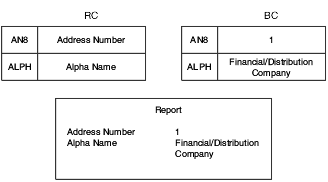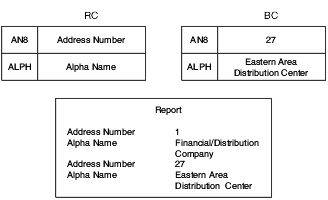23 Understanding Runtime Processing
This chapter contains the following topics:
23.1 Batch Runtime Processing
The term batch runtime processing refers to how events and their attached event rules are evaluated at runtime.
Data is stored in memory in an internal data structure, or runtime structure, during runtime processing. Certain fields of the data structure temporarily store data during runtime until it is no longer needed. Then data can be cleared to process another record.
Oracle's JD Edwards EnterpriseOne Report Design Aid (RDA) provides several different field types and event rules that are associated with runtime structures. You need to understand the values that are held in the runtime structure at different points during the processing of a report. To explain the values that are held in runtime structures at a given time, you need to first understand the objects that are available and their two-character, alphabetical code.
23.1.1 Available Objects
Available objects are represented by a two-character, alphabetical code that indicates the source of the data and determines how the data is used in reports and batch processes at runtime.
This table describes the available objects that are defined for batch processing:
| Object | Description |
|---|---|
| BC | Business view columns. Columns that are included in the attached business view. These columns are populated with values from the database when a fetch is performed, and those values are the values that are saved to the database during an add or update. |
| PO | Processing option values. These values are passed into the application when the batch version is submitted. These processing option values are entered by the user or defined in a particular version of an application. |
| VA | Event rules variables. Variables that you create in event rules using data dictionary items. They are not manipulated by the system. |
| SV | System variables. Values that represent environment variables that are made accessible to event rules. |
| SL | System values. Values that represent constant system values that have been made accessible to event rules. |
| TV | Text variables. Variables that you create in RDA for use in event rules. |
| RC | Report constants. Includes column headings in columnar sections and the constant portion of fields in group sections. |
| RV | Report variables. |
| PC | Previous business view columns. Columns that are included in the attached business view. These columns are the previous values for a field rather than the value currently in memory. |
| PV | Previous report variables. |
23.1.2 Typical Event Flow for Group Sections
The runtime engine processes events in a specific order. Some examples are provided in the following sections to help you understand the values that are held in the runtime structures after specific group section events are processed by the system.
23.1.2.1 Initialize Section
This example illustrates the values that are held in the runtime structures after the system processes the Initialize Section event for the group section of an address book report:
Figure 23-1 Runtime structure values after Initialize Section event

Description of "Figure 23-1 Runtime structure values after Initialize Section event"
23.1.2.2 Advance Section
This example illustrates the values that are held in the runtime structures after these group section events are processed by the system:
-
Initialize Section
-
Advance Section
Figure 23-2 Runtime structure values after Advance Section event

Description of "Figure 23-2 Runtime structure values after Advance Section event"
23.1.2.3 Before Level Break
This example illustrates the values that are held in the runtime structures after these group section events are processed by the system:
-
Initialize Section
-
Advance Section
-
Before Level Break
Figure 23-3 Runtime structure values after Before Level Break event

Description of "Figure 23-3 Runtime structure values after Before Level Break event"
23.1.2.4 Do Section
This example illustrates the values that are held in the runtime structures after these group section events are processed by the system:
-
Initialize Section
-
Advance Section
-
Before Level Break
-
Do Section
Figure 23-4 Runtime structure values after Do Section event

Description of "Figure 23-4 Runtime structure values after Do Section event"
23.1.2.5 After Last Object Printed
This example illustrates the values that are held in the runtime structures after these group section events are processed by the system and shows the data that appears in the report:
-
Initialize Section
-
Advance Section
-
Before Level Break
-
Do Section
-
After Last Object Printed
Figure 23-5 Runtime structure values after the After Last Object Printed event

Description of "Figure 23-5 Runtime structure values after the After Last Object Printed event"
23.1.2.6 Advance Section
This example illustrates the values that are held in the runtime structures after these group section events are processed by the system and shows the data that appears in the report:
-
Initialize Section
-
Advance Section
-
Before Level Break
-
Do Section
-
After Last Object Printed
-
Advance Section
Figure 23-6 Runtime structure values after Advance Section event

Description of "Figure 23-6 Runtime structure values after Advance Section event"
23.1.2.7 Before Level Break
This example illustrates the values that are held in the runtime structures after these group section events are processed by the system and shows the data that appears in the report:
-
Initialize Section
-
Advance Section
-
Before Level Break
-
Do Section
-
After Last Object Printed
-
Advance Section
-
Before Level Break
Figure 23-7 Runtime structure values after Before Level Break event

Description of "Figure 23-7 Runtime structure values after Before Level Break event"
23.1.2.8 Do Section
This example illustrates the values that are held in the runtime structures after these group section events are processed by the system and shows the data that appears in the report:
-
Initialize Section
-
Advance Section
-
Before Level Break
-
Do Section
-
After Last Object Printed
-
Advance Section
-
Before Level Break
-
Do Section
Figure 23-8 Runtime structure values after Do Section event

Description of "Figure 23-8 Runtime structure values after Do Section event"
23.1.2.9 After Last Object Printed
This example illustrates the values that are held in the runtime structures after these group section events are processed by the system and shows the data that appears in the report:
-
Initialize Section
-
Advance Section
-
Before Level Break
-
Do Section
-
After Last Object Printed
-
Advance Section
-
Before Level Break
-
Do Section
-
After Last Object Printed
Figure 23-9 Runtime structure values after the After Last Object Printed event

Description of "Figure 23-9 Runtime structure values after the After Last Object Printed event"
23.1.2.10 Advance Section
This example illustrates the values that are held in the runtime structures after these group section events are processed by the system and shows the data that appears in the report:
-
Initialize Section
-
Advance Section
-
Before Level Break
-
Do Section
-
After Last Object Printed
-
Advance Section
-
Before Level Break
-
Do Section
-
After Last Object Printed
-
Advance Section
Figure 23-10 Runtime structure values after Advance Section event

Description of "Figure 23-10 Runtime structure values after Advance Section event"